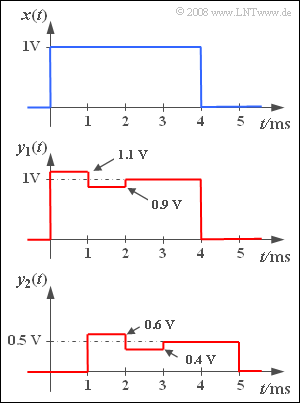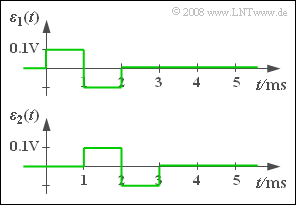Difference between revisions of "Aufgaben:Exercise 2.2: Distortion Power"
| (16 intermediate revisions by the same user not shown) | |||
| Line 6: | Line 6: | ||
A rectangular pulse x(t) with amplitude 1V and duration 4ms is applied to the input of a communication system. Then, the pulse y1(t) , whose signal parameters can be taken from the middle sketch, is measured at the system output. | A rectangular pulse x(t) with amplitude 1V and duration 4ms is applied to the input of a communication system. Then, the pulse y1(t) , whose signal parameters can be taken from the middle sketch, is measured at the system output. | ||
| − | + | At the output of another system S2 , the signal $y_2(t)$ shown in the lower sketch is obtained with the same input signal $x(t)$ . | |
| − | + | Let the following definition apply to the error signal used in this task: | |
:ε(t)=y(t)−α⋅x(t−τ). | :ε(t)=y(t)−α⋅x(t−τ). | ||
| − | + | The parameters α and τ are to be determined such that the distortion power (the mean squared error) is minimal. For this, the following holds: | |
:$$P_{\rm V} = \overline{\varepsilon^2(t)} = \frac{1}{T_{\rm M}} \cdot \int\limits_{ ( T_{\rm M})} | :$$P_{\rm V} = \overline{\varepsilon^2(t)} = \frac{1}{T_{\rm M}} \cdot \int\limits_{ ( T_{\rm M})} | ||
{\varepsilon^2(t) }\hspace{0.1cm}{\rm d}t$$ | {\varepsilon^2(t) }\hspace{0.1cm}{\rm d}t$$ | ||
| − | + | These definitions already take into account that a frequency-independent damping just as a runtime which is constant for all frequencies does not contribute to the distortion. | |
| − | + | The integration interval has to be chosen appropriately in each case: | |
| − | * | + | *Use the interval 0 ... 4ms for $y_1(t)$ and the interval 1ms ... 5ms for y2(t) . |
| − | * | + | *Thus, the measurement time is TM=4ms in both cases. |
| − | * | + | *It is obvious that with respect to y1(t) the parameters α=1 and τ=0 respectively result in the minimum distortion power. |
| − | + | In general, the so-called signal–to–distortion–power ratio is given by the following formula | |
:ρV=α2⋅PxPV. | :ρV=α2⋅PxPV. | ||
| − | + | Here, | |
| − | *Px | + | *Px denotes the power of the signal x(t), and |
| − | *α2⋅Px | + | *α2⋅Px denotes the power of y(t)=α⋅x(t−τ), that would arise as aresult in the absence of distortion. |
| − | + | Usually, – as also in this task– this S/N-ratio ρV is given logarithmically in dB . | |
| Line 48: | Line 48: | ||
<quiz display=simple> | <quiz display=simple> | ||
| − | { | + | {Determine the distortion power of the system S1. |
|type="{}"} | |type="{}"} | ||
PV1 = { 5 3% } ⋅10−3 V2 | PV1 = { 5 3% } ⋅10−3 V2 | ||
| − | { | + | {Compute the signal–to–distortion–power ratio for system S1. |
|type="{}"} | |type="{}"} | ||
10⋅lg ρV1 = { 23.01 3% } dB | 10⋅lg ρV1 = { 23.01 3% } dB | ||
| − | { | + | {What parameters α and τ should be used to calculate the distortion power of the system S2 ? <br>Justify your result. |
|type="{}"} | |type="{}"} | ||
α = { 0.5 3% } | α = { 0.5 3% } | ||
| Line 64: | Line 64: | ||
| − | { | + | {Determine the distortion power of the system S2. |
|type="{}"} | |type="{}"} | ||
PV2 = { 5 3% } ⋅10−3 V2 | PV2 = { 5 3% } ⋅10−3 V2 | ||
| − | { | + | {Compute the signal–to–distortion–power ratio for the system S2. <br>Interpret the different results. |
|type="{}"} | |type="{}"} | ||
10⋅lg ρV2 = { 16.99 3% } dB | 10⋅lg ρV2 = { 16.99 3% } dB | ||
| Line 79: | Line 79: | ||
===Solution=== | ===Solution=== | ||
{{ML-Kopf}} | {{ML-Kopf}} | ||
| − | [[File:P_ID915__LZI_A_2_2_a.png|right|frame| | + | [[File:P_ID915__LZI_A_2_2_a.png|right|frame|Resulting error signals]] |
| − | '''(1)''' | + | '''(1)''' The error signal ε1(t) shown in the graph is obtained with the given parameters α=1 and τ=0 . The distortion power is thus equal to: |
:$$P_{\rm V1} = \frac{ {1 \, \rm ms}}{4 \, \rm ms} \cdot \big[ ({0.1 \, \rm V})^2 + | :$$P_{\rm V1} = \frac{ {1 \, \rm ms}}{4 \, \rm ms} \cdot \big[ ({0.1 \, \rm V})^2 + | ||
({-0.1 \, \rm V})^2\big]\hspace{0.3cm}\Rightarrow \hspace{0.3cm}P_{\rm V1} \hspace{0.15cm}\underline{ = 5 \cdot 10^{-3} \, \rm V^2}. $$ | ({-0.1 \, \rm V})^2\big]\hspace{0.3cm}\Rightarrow \hspace{0.3cm}P_{\rm V1} \hspace{0.15cm}\underline{ = 5 \cdot 10^{-3} \, \rm V^2}. $$ | ||
| Line 86: | Line 86: | ||
| − | '''(2)''' | + | '''(2)''' The power of the input signal is: |
:Px=14ms⋅(1V)2⋅4ms=1V2. | :Px=14ms⋅(1V)2⋅4ms=1V2. | ||
| − | * | + | *The following is obtained for the signal–to–distortion–power ratio with the result from '''(1)''' : |
$$\rho_{\rm V1} = \frac{ P_{x}}{P_{\rm V1}}= \frac{ {1 \, \rm | $$\rho_{\rm V1} = \frac{ P_{x}}{P_{\rm V1}}= \frac{ {1 \, \rm | ||
V^2}}{0.005 \, \rm V^2}\hspace{0.05cm}\rm = 200\hspace{0.3cm} \Rightarrow \hspace{0.3cm} | V^2}}{0.005 \, \rm V^2}\hspace{0.05cm}\rm = 200\hspace{0.3cm} \Rightarrow \hspace{0.3cm} | ||
| Line 96: | Line 96: | ||
| − | '''(3)''' | + | '''(3)''' The sketch on the information sheet makes it clear that even without the distortions occuring – but due to attenuation and runtime alone – the signal y(t) would differ significantly from x(t) . |
| − | * | + | *The following would arise as a result: y(t)=0.5⋅x(t−1 ms) . |
| − | * | + | *If someone does not immediately perceive these values from the graph, then first the error signal |
:ε2(t)=y2(t)−α⋅x(t−τ) | :ε2(t)=y2(t)−α⋅x(t−τ) | ||
| − | : | + | :and afterwards the mean squared error for very (infinitely) many α– and τ–values would have to be determined, in doing so the integration interval is to be adjusted to τ in each case. |
| − | * | + | *Then, the smallest possible result would also be obtained for α=0.5_ and τ=1 ms_ . However, for this optimization of α and τ the useage of a computer program should be granted. |
| − | '''(4)''' | + | '''(4)''' The above sketch shows that ε2(t) is equal to the error signal $\varepsilon_1(t)$ except for a shift by $1 \ \rm ms$ . Considering the integration interval 1 ms ... 5 ms the same distortion power is obtained: |
:PV2=PV1=5⋅10−3V2_. | :PV2=PV1=5⋅10−3V2_. | ||
| − | '''(5)''' | + | '''(5)''' According to the information sheet the following holds: |
:$$\rho_{\rm V2} = \frac{ \alpha^2 \cdot P_{x}}{P_{\rm V2}}= \frac{ 0.5^2 \cdot {1 \, \rm | :$$\rho_{\rm V2} = \frac{ \alpha^2 \cdot P_{x}}{P_{\rm V2}}= \frac{ 0.5^2 \cdot {1 \, \rm | ||
V^2}}{0.005 \, \rm V^2}\hspace{0.05cm}\rm = 50\hspace{0.3cm} \Rightarrow \hspace{0.3cm} | V^2}}{0.005 \, \rm V^2}\hspace{0.05cm}\rm = 50\hspace{0.3cm} \Rightarrow \hspace{0.3cm} | ||
10 \cdot {\rm lg}\hspace{0.1cm}\rho_{\rm V2} \hspace{0.15cm}\underline{= {16.99 \, \rm dB}}.$$ | 10 \cdot {\rm lg}\hspace{0.1cm}\rho_{\rm V2} \hspace{0.15cm}\underline{= {16.99 \, \rm dB}}.$$ | ||
| − | * | + | *Despite the same distortion power 10⋅lgρV2 is less than 10⋅lgρV1 by about 6 dB . |
| − | * | + | *The signal y2(t) is thus significantly less favourable in terms of SNR than y1(t). |
| − | * | + | *It is considered that now the power of the output signal is only a quarter of the input power due to α=0.5 . |
| − | * | + | *If this attenuation at the output was to be compensated by amplifying it by 1/α, the distortion power would indeed increase by α2. |
| − | * | + | *The signal-to-distortion-power ratio ρV2 would, however, remain the same because the "useful signal" would also be increased by the same value. |
{{ML-Fuß}} | {{ML-Fuß}} | ||
Latest revision as of 22:51, 12 September 2021
A rectangular pulse x(t) with amplitude 1V and duration 4ms is applied to the input of a communication system. Then, the pulse y1(t) , whose signal parameters can be taken from the middle sketch, is measured at the system output.
At the output of another system S2 , the signal y2(t) shown in the lower sketch is obtained with the same input signal x(t) .
Let the following definition apply to the error signal used in this task:
- ε(t)=y(t)−α⋅x(t−τ).
The parameters α and τ are to be determined such that the distortion power (the mean squared error) is minimal. For this, the following holds:
- PV=¯ε2(t)=1TM⋅∫(TM)ε2(t)dt
These definitions already take into account that a frequency-independent damping just as a runtime which is constant for all frequencies does not contribute to the distortion.
The integration interval has to be chosen appropriately in each case:
- Use the interval 0 ... 4ms for y1(t) and the interval 1ms ... 5ms for y2(t) .
- Thus, the measurement time is TM=4ms in both cases.
- It is obvious that with respect to y1(t) the parameters α=1 and τ=0 respectively result in the minimum distortion power.
In general, the so-called signal–to–distortion–power ratio is given by the following formula
- ρV=α2⋅PxPV.
Here,
- Px denotes the power of the signal x(t), and
- α2⋅Px denotes the power of y(t)=α⋅x(t−τ), that would arise as aresult in the absence of distortion.
Usually, – as also in this task– this S/N-ratio ρV is given logarithmically in dB .
Please note:
- The exercise belongs to the chapter Classification of the Distortions.
- In particular, consider the pages
Questions
Solution
(1) The error signal ε1(t) shown in the graph is obtained with the given parameters α=1 and τ=0 . The distortion power is thus equal to:
- PV1=1ms4ms⋅[(0.1V)2+(−0.1V)2]⇒PV1=5⋅10−3V2_.
(2) The power of the input signal is:
- Px=14ms⋅(1V)2⋅4ms=1V2.
- The following is obtained for the signal–to–distortion–power ratio with the result from (1) :
ρV1=PxPV1=1V20.005V2=200⇒10⋅lgρV1=23.01dB_.
(3) The sketch on the information sheet makes it clear that even without the distortions occuring – but due to attenuation and runtime alone – the signal y(t) would differ significantly from x(t) .
- The following would arise as a result: y(t)=0.5⋅x(t−1 ms) .
- If someone does not immediately perceive these values from the graph, then first the error signal
- ε2(t)=y2(t)−α⋅x(t−τ)
- and afterwards the mean squared error for very (infinitely) many α– and τ–values would have to be determined, in doing so the integration interval is to be adjusted to τ in each case.
- Then, the smallest possible result would also be obtained for α=0.5_ and τ=1 ms_ . However, for this optimization of α and τ the useage of a computer program should be granted.
(4) The above sketch shows that ε2(t) is equal to the error signal ε1(t) except for a shift by 1 ms . Considering the integration interval 1 ms ... 5 ms the same distortion power is obtained:
- PV2=PV1=5⋅10−3V2_.
(5) According to the information sheet the following holds:
- ρV2=α2⋅PxPV2=0.52⋅1V20.005V2=50⇒10⋅lgρV2=16.99dB_.
- Despite the same distortion power 10⋅lgρV2 is less than 10⋅lgρV1 by about 6 dB .
- The signal y2(t) is thus significantly less favourable in terms of SNR than y1(t).
- It is considered that now the power of the output signal is only a quarter of the input power due to α=0.5 .
- If this attenuation at the output was to be compensated by amplifying it by 1/α, the distortion power would indeed increase by α2.
- The signal-to-distortion-power ratio ρV2 would, however, remain the same because the "useful signal" would also be increased by the same value.

